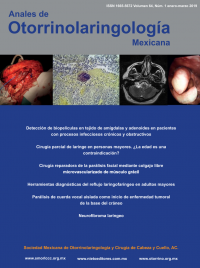Diagnostic tools of laryngophrarynx reflux in elderly patients.
An Orl Mex. 2019 enero-marzo;64(1):20-24.

Juana Cristina Lezo-Salazar,1 G Mauricio Morales-Cadena,2 Mariana Gabriela Fonseca-Chávez,3 Benjamín Valente-Acosta,4Edgar Enrique Durán-Ruiz1
1 Residente de cuarto año del curso de Posgrado de Otorrinolaringología y Cirugía de Cabeza y Cuello.
2 Profesor titular del curso de Posgrado de Otorrinolaringología y Cirugía de Cabeza y Cuello.
3 Médico asociado del Servicio de Otorrinolaringología y Cirugía de Cabeza y Cuello.
Facultad Mexicana de Medicina de la Universidad La Salle, Hospital Español de México, Ciudad de México.
4 Servicio de Medicina Interna, Centro Médico ABC, Ciudad de México.
Resumen
OBJETIVO: Evaluar herramientas accesibles y no invasivas en adultos mayores para el diagnóstico oportuno del reflujo laringofaríngeo.
MATERIAL Y MÉTODO: Estudio prospectivo, descriptivo, longitudinal y analítico. Se valoraron pacientes adultos mayores de 60 años de edad con tos no productiva como síntoma principal de consulta y con alta sospecha de reflujo laringofaríngeo que acudieron al Servicio de Otorrinolaringología y Cirugía de Cabeza y Cuello del Hospital Español de México, de enero a mayo de 2018. Se aplicaron las escalas índice de síntomas por reflujo laringofaríngeo (ISR) y escala de hallazgos en nasofibrolaringoscopia (HNF). A los pacientes con puntajes alterados se les indicó tratamiento médico. Se repitió la valoración con las dos escalas un mes después del inicio de tratamiento médico. Los análisis estadísticos se realizaron con el programa SPSS 15.0 para Windows (SPSS, Chicago, IL, Estados Unidos).
RESULTADOS: Se evaluaron 100 pacientes mayores de 60 años, se excluyeron 30 pacientes. La media del puntaje total pretratamiento del ISR fue de 16.22 y postratamiento de 6.42; con la escala HNF la media del puntaje final pretratamiento fue de 10.18 y la postratamiento de 4.04. En ambas hubo disminución estadísticamente significativa (p < 0.001).
CONCLUSIONES: Las escalas índice de síntomas por reflujo laringofaríngeo y de hallazgos en nasofibrolaringoscopia son herramientas diagnósticas efectivas, no invasivas y de bajo costo para establecer el diagnóstico de reflujo laringofaríngeo en pacientes mayores de 60 años.
PALABRAS CLAVE: Reflujo laringofaríngeo; tos; adulto mayor.
Abstract
OBJECTIVE: To evaluate accessible and non-invasive tools in older adults for the timely diagnosis of the laryngopharyngeal reflux.
MATERIAL AND METHOD: A prospective, transversal and analytical study was carried out. There were included patients older than 60 years with non-productive cough as the main symptom and with high suspicion of laryngopharyngeal reflux who attended the Otolaryngology and Head and Neck Service of the Hospital Español de Mexico from January 2018 to May 2018. The reflux symptom index (RSI) and the reflux finding score (RFS) were applied. Patients with altered scores were referred for medical treatment. The assessment was repeated with the two scales one month after the medical treatment. Statistical analyses were performed with SPSS 15.0 for Windows (SPSS, Chicago, IL, USA).
RESULTS: One hundred patients were evaluated, 30 patients were excluded. The average of the total pretreatment score of the RSI was 16.22 and post-treatment of 6.42; the average of the final RFS pretreatment was 10.18 and post-treatment of 4.04, resulting in both a statistically significant decrease (p < 0.001).
CONCLUSIONS: The reflux symptom index and the reflux finding score are effective, non-invasive and low cost diagnostic tools of the laryngopharyngeal reflux in patients older than 60 years.
KEYWORDS: Laryngopharyngeal reflux; Cough; Elderly.

